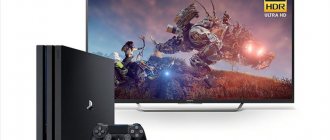The TV technology industry is constantly evolving. New technologies are emerging that improve the viewing experience. Today, users have little understanding of the features of 4K and UHD TVs. What is this?
This is exactly what we will talk about now. Let's study the features of this format in detail. Let's look at how it differs from other standards. Let's analyze whether it's worth spending money on buying a TV with 4K support.
What format is 4K
The first information about this format appeared back in 2012, when developers from leading companies were actively working to increase the value that determines the number of pixels per unit area of the image. World-famous manufacturers were interested in the emergence of new technologies. After all, they would help attract the attention of the target audience.
Representatives of LG brought a 3D-TV with support for the 4K UHD format to one of the presentations held in 2012. Competitors also tried to keep up. Therefore, very quickly 4K TVs from other brands began to appear at such exhibitions.
Even 6 years ago it became clear that the new standard would take root. Colorful and realistic images began to appear on the screens, attracting the attention of users. However, in 2012, not everyone could afford to purchase such a device. Therefore, we had to wait a little over 5 years until the format began to be used everywhere.
What is 4K? This is a new format that replaced the outdated 2K (appeared immediately after Full HD). Many users completely missed 2K TV because it didn’t exist for long. Today, such screens are used in the process of creating displays for mobile phones.
The key feature of 4K compared to its analogues is its high resolution. There is a maximum number of pixels per unit area of the image. If we compare the new format with 2K, it is almost twice as good as its predecessor. Now you know what the 4K standard is for.
There is no single resolution for this format. There are six different standards:
- full frame – 4096x3072 pixels. Almost unpopular;
- academic – 3656x2664 pixels. Actively used by film studios;
- cassette - another cinematic side with a resolution of 3996x2160 pixels;
- DCI – used in video cameras. Modern smartphones support this standard. Resolution 4096x2160;
- widescreen - standard used in the field of cinema. Resolution – 4096x1716;
- Ultra HD – ultra high definition television. This is the standard supported by modern TVs. Resolution – 3840x2160 pixels.
It is UHD that is most popular among all existing standards.
How 4K differs from UHD
Everything is very simple. What is 4K? This is a professional production standard. Ultra HD is the standard for televisions and other consumer displays. The term 4K applies to displays of various formats with a horizontal resolution of 4000 pixels. This fact confuses users a little, since in low resolutions the format is written in terms of the number of vertical pixels - 1080i or 720p.
Ultra HD is an almost identical concept except that it is more often used when talking about TV. Resolution – 3840x2160. Based on this:
- DCI standard is a professional manufacturing designation that is common in the manufacturing of digital devices with a resolution of 4096x2160;
- The UHD standard is often called 4K Ultra HD. The standard used for marking televisions with a resolution of 3840x2160.
Concepts such as 4K and Ultra HD began to be actively used after the digital cinema consortium. The DCI Association is involved in standardizing permits. The name was not chosen by chance. The resolution of 4096x3072 pixels is exactly four times greater than Full HD (experts often call it 1K).
After carefully re-reading the information presented above, you will understand that Ultra HD does not at all fit the definition of the term 4K. In terms of resolution, it falls short. However, why do electronics manufacturers still use the 4K Ultra HD label?
The current trend is explained by marketing objectives. High screen resolution increases sales of a particular TV or set-top box. Therefore, manufacturers try not to violate the standardization established by the DCI consortium. Designations such as 4K Ultra HD will increase the popularity of TV. Even though in fact the permit does not comply with the standards established by the regulations.
In fact, the difference in pixels is not too significant. Visually the user will not notice any differences. The brightness, saturation and clarity of the picture are affected not only by resolution, but also by other parameters.
How to achieve high-quality images
To get high-quality 4K content, you will need:
- A TV or monitor whose matrix supports the format.
- A device that will decode the incoming video signal - it can be built into the TV model or separate.
- HDMI 2.0-2.1 cable. for lossless video transmission.
- If you plan to watch videos online, make sure you have an Internet connection with a speed of at least 20 Mbit per second.
- Video of the required standard. Consider videos from the last 2-5 years of shooting. Before this, 4K technology was not used, but enthusiasts are actively trying to bring the quality of old films to 4K - the resolution increases, but does not reach the required level.
When selecting an HDMI cable, buy options marked “High-Speed” and “Premium HDMI Certified”. Don't pay attention to other motivational inscriptions.
Advantages and disadvantages of the format
The strengths of TVs that support this format are obvious:
- high-quality, realistic, rich and clear image. All parts of the picture have excellent detail, there are no defects;
- 4K devices are ideal for video game fans. Thanks to the maximum realism of the image, the game will be much more interesting;
- Screens with maximum resolution are suitable for professional photographers and camera operators. Editing photos and videos on a high-resolution screen is much more convenient;
- You can display your presentation on the big screen. A high-quality picture will also come in handy when surfing the Internet.
4K TV means high-quality and realistic images. However, there are also some disadvantages. Let us list the main weaknesses of the format in question:
- TV channels included in free digital TV multiplexes are broadcast at best in 720p quality. Therefore, it is absolutely impossible to appreciate all the advantages and maximum clarity of Ultra HD while watching television.
- There is also very little 4K media content on the Internet. At best, you will find a few films and clips.
- A TV that supports this format is much more expensive than its Full HD counterparts. We are talking about an overpayment of $150-200. Provided identical functionality.
- Gamers will also face problems. Even new games released on PlayStation 4 and Xbox One consoles do not support this format. Therefore, you will have to play only online applications, which are also very few.
Image quality is about more than just screen resolution. You need to take into account sharpness, GPU power, noise reduction features, etc. Therefore, sometimes a cheap 4K TV will have a lower quality picture than a regular device with Full HD resolution.
What is 8K
Logically, the resolution of this format should be twice as many pixels as 4K. However, this is not quite true. The thing is that we are talking about 2 dimensions at once. Pixels are arranged horizontally and vertically. Super Ultra HD (8K) TVs can fit the pixels of 16 Full HD screens. Resolution – 7680x4320 pixels.
The history of 8K TVs
The first version of the device supporting this HD resolution was presented during the CES exhibition, which took place in 2013. Developers representing the Sharp company demonstrated a TV with a screen diagonal of 83 inches.
Over the next few years, 8K TVs from other well-known companies were introduced. The greatest progress in this direction has been made by the Japanese organization NHK, through whose efforts a satellite broadcast with a resolution of 7680x4320 pixels was launched in 2014.
In 2021, some events at the Summer Olympics in Rio de Janeiro were also broadcast in 8K resolution. Spectators were able to watch a live broadcast of the largest sports tournament in special cinemas.
When will 8K TVs become available?
During the presentation of new models of TV equipment at the annual CES exhibition, leading manufacturers: LG, Samsung, Sony presented their versions of 8K TVs. Therefore, it was in 2021 that a real breakthrough occurred in this area. Despite the fact that the first such TV appeared five years ago.
If we compare this innovative standard with 4K, the situation develops according to a similar scenario. The cost of 4K TVs is gradually falling. They cannot be called budget, but they have already become more affordable. Therefore, probably in 3-4 years everyone will be able to purchase a TV with maximum resolution. The emergence of new technologies can provoke a price collapse.
The first 8K TV went on sale in 2015. However, this Sharp model is intended for professional use only. Sold only in Japan. The average cost of such a device is $130,000.
In September 2021, Sharp announced the start of sales of the LC-70X500 model with 8K support. A little more than a year has passed since that moment, the price of the device has dropped to almost $70,000.
Premium Selection
The premium segment of 4K TVs (90-100 thousand rubles and above) is widely represented in Russian retail, but now the attention of connoisseurs of flagship models is focused on new products for the spring-summer 2021 season. As a rule, TV manufacturers announce new models once every six months - at the beginning of the year and on the eve of the start of the school year.
Moreover, they appear in retail at the end of spring and on the eve of Christmas sales. Today in Russian stores you can already find a unique 77-inch LG OLED77W8 TV (approximately 1.5 million rubles) from the premium LG SIGNATURE series, made on the new generation of OLED matrices, the Alpha9 intelligent processor and LG AI TV technology.
77-inch OLED TV LG OLED77W8
The LG OLED77W8 features all the latest technology developments, including support for most HDR formats, including HDR10 Pro, Dolby Vision, Technicolor Advanced HDR, HDR10 Pro and HLG Pro, as well as Dolby Atmos cinema audio technology.
Among the new 4K TVs with QLED technology for 2021, we can note the flagship Samsung Q9F with full direct backlight technology and a 75-inch diagonal. The eldest model in the series, QE75Q9FNAUXRU, supports Q HDR Elite technology (HDR 10+) and Ultra Black Elite technology with anti-reflection elements on the matrix film, which reduces light reflection and increases the contrast range.
75-inch QLED TV Samsung QE75Q9FNAUXRU
The Samsung QE75Q9FNAUXRU TV uses the new Q Engine to process and optimize complex color solutions. At retail, the new product is offered at a price of approximately 500 thousand rubles.
Among Samsung's new products there is another interesting 75-inch QLED novelty - the QE75Q8CAMUXRU model with a curved screen priced from 280 thousand rubles.
Samsung 75" Curved QLED TV QE75Q8CAMUXRU
The TV features a combination of the latest version of quantum dot technology with Q HDR 1500 wide dynamic range technology, as well as an interesting design with a smooth textured metal back panel without tangled visible wires.
Among the new premium class products, the new 4K Sony BRAVIA TVs deserve special attention - both with OLED screens and traditional LCD panels. The 65-inch model Sony KD-65AF8 with an OLED matrix at a price of about 350 thousand rubles is interesting for its high level of contrast and the ability to convey perfect black color.
65-inch OLED TV Sony BRAVIA KD-65AF8
The TV's 4K HDR X1 Extreme processor processes images in real time, enhancing detail and upgrading any video to near 4K HDR quality. Unlike conventional TVs, the Sony KD-65AF8 model uses Acoustic Surface technology to transmit sound across the entire surface of the screen.
Triluminos Display technology combined with Dolby Vision is capable of reproducing a wide range of vibrant colors. The 4K HDR TV with Android TV also features voice control so you can search for movies and TV shows across apps and broadcast channels simply by speaking their titles.
In the Sony BRAVIA XF90 TV range, the company presented the 75-inch flagship KD-75XF9005 (price approximately 400 thousand rubles) with the X1 Extreme processor, support for the HDR format Dolby Vision, X-Motion Clarity technology for smooth transmission of dynamic scenes, X-tended technology Dynamic Range PRO to enhance video quality in a variety of formats, including HDR, by adjusting the backlight brightness in specific areas of the screen.
75-inch LCD TV Sony BRAVIA KD-75XF9005
Like all new Sony BRAVIA products, the KD-75XF9005 TV is based on the Android TV platform and supports voice search for quick access to the desired content and control of the TV.
Is it worth buying a 4K TV now?
The market value of such devices is rapidly falling. However, there is still very little content in this format. Consider 4K technology in TVs as an optimal solution in the near future. As a result, you can get maximum pleasure from watching new cinematic releases at home.
The development of innovative technologies is a dynamic process. Therefore, the amount of media content will gradually increase. It will be distributed not only online, but also through Blu-Ray discs.
There are a lot of popular TV models that support this format. But only now the channels (not all) are broadcast in HD. Although this format appeared back in 1998. Perhaps the popularization of 4K will happen faster.
Now there is no point in overpaying for this permit. A regular TV with Full HD support is quite enough.
https://www.youtube.com/watch?v=eRXDt47aE-0
How much content is available for 4K TV
There are enough 4K videos to regularly fill up terabyte hard drives. All modern cinema has switched to 4K, and old films have begun to be adjusted to it.
To get content you can use:
- search networks;
- satellite telecom operators - most offer 4K packages;
- streaming services such as Netflix or Amazon Prime;
- discs with licensed products.
For the last 3 options considered, you will have to pay a subscription or one-time fee.











